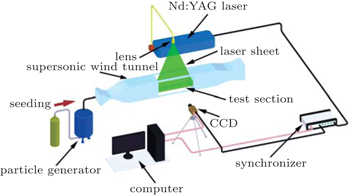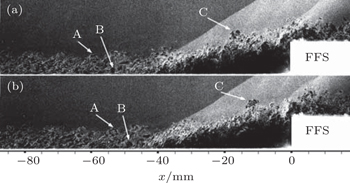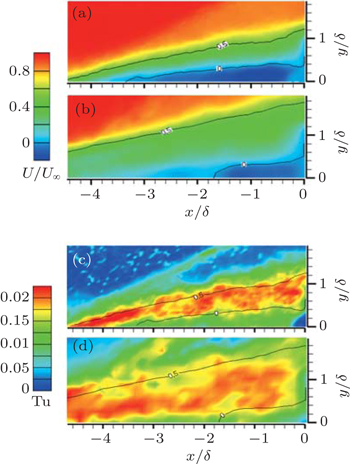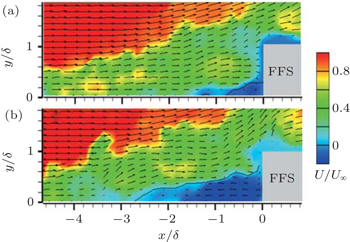† Corresponding author. E-mail:
Project supported by the National Natural Science Foundation of China (Grant Nos. 11172326 and 11502280).
The effects of the micro-ramps on supersonic turbulent flow over a forward-facing step (FFS) was experimentally investigated in a supersonic low-noise wind tunnel at Mach number 3 using nano-tracer planar laser scattering (NPLS) and particle image velocimetry (PIV) techniques. High spatiotemporal resolution images and velocity fields of supersonic flow over the testing model were captured. The fine structures and their spatial evolutionary characteristics without and with the micro-ramps were revealed and compared. The large-scale structures generated by the micro-ramps can survive the downstream FFS flowfield. The micro-ramps control on the flow separation and the separation shock unsteadiness was investigated by PIV results. With the micro-ramps, the reduction in the range of the reversal flow zone in streamwise direction is 50% and the turbulence intensity is also reduced. Moreover, the reduction in the average separated region and in separation shock unsteadiness are 47% and 26%, respectively. The results indicate that the micro-ramps are effective in reducing the flow separation and the separation shock unsteadiness.
Shock wave/boundary layer interactions (SWBLIs) have been the subject of experimental and computational research for decades owing to their practical importance in many aircrafts involving transonic or supersonic flows.[1,2] Sufficiently strong interactions can cause unstable separation and result in unsteady pressure and heat loads. Therefore, flow control strategies have been investigated to reduce the harmful effects by the SWBLIs. Although the conventional bleeding techniques have been widely used in SWBLIs control, there are some drawbacks such as high drag and mechanical complicity.[3,4] The micro vortex generators (MVGs) with a height lower than boundary layer thickness have the merits of lower drag and physical simplicity and are considered to be a hopeful alternative for bleeding techniques. In recent years, MVGs have attracted widespread attention for their promising utility in delaying separation caused by SWBLIs.
The MVGs are designed to introduce pairs of counter-rotating streamwise vortices and these flow structures can improve the characteristics of the boundary layer, which are beneficial to reduce flow separation.[5,6] The micro-ramp is one type of MVGs. Anderson et al.[7] used numerical simulations to determine optical designs of the micro-ramp and their results show that the micro-ramps are structurally highly robust and very affordable. Babinsky et al.[8] experimentally investigated the flow control ability of micro-ramps with various ramp heights. They found that the field downstream of the micro-ramp was dominated by two counter-rotating primary vortices that act to entrain high-momentum fluid from the outer regions of the boundary layer toward the surface.
Blinde et al.[9] used stereoscopic particle image velocimetry (PIV) to investigate the effects of the micro-ramps on SWBLIs. Different from the results of Babinsky, they found that the micro-ramps generate individual vortex pair packets downstream of their vertices, which act like longitudinal streamwise vortex pairs in a time-average view. Subsequently, Sun et al.[10,11] showed that the ring vortices were very important for the SWBLIs control. Due to the debates on the flow topology, the fine flow structures of the micro-ramps’ control on SWBLIs need further investigation.
The reduction in the separation length and flow unsteadiness is an important aspect of the micro-ramp control. The results of Blinde et al.[9] show that the probability of reversed-flow occurrence is reduced by 20% to 30% and the shock motion amplitude is reduced by about 20%. Verma et al.[12] conducted experimental studies to control shock unsteadiness in a 24° compression ramp using MVGs. Their results show that it helps to alleviate the fluctuations of the separation shock as well as the fluctuating pressure loads in the intermittent region of separation. Very recently, Giepman et al.[13] investigated the influences of micro-ramp size and location on its effectiveness for SWBLIs control. Typical reductions in the average separation region 87% and shock unsteadiness 51% were recorded in their study.
Shock wave/boundary layer interactions for a forward-facing step (FFS) play an important role in both fundamental research and many practical applications.[14,15] In the present study, the flow control of micro-ramps on supersonic flow over an FFS is experimentally investigated using nano-tracer planar laser scattering (NPLS) and PIV techniques. The rest of the present work is arranged as follows. In Section 2, the flow facility and NPLS technique are described in detail. The flow imaging and control effects of the micro-ramps on supersonic FFS flow are given in Section 3. Lastly, conclusions are made in Section 4.
The experiments were performed in a supersonic low-noise wind tunnel at Mach number 3 (Fig.
| Table 1. Experimental parameters. . |
The NPLS is an optical flow visualization technique based on Rayleigh scattering, which uses the nanoparticles as tracer particles.[16] It has been used to investigate the supersonic mixing layer, boundary layer, compression ramp, aero-optics, and so forth.[17–19] As shown in Fig.
Instantaneous images of Mach 3 turbulent flow over the FFS without and with micro-ramps are shown in Fig.
 | Fig. 5. Instantaneous images of Mach 3 flow over the FFS (a) without micro-ramps and (b) with micro-ramps. |
Figures
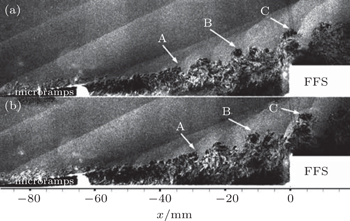 | Fig. 7. An image pair with a 10-μs delay of Mach 3 flow over the FFS with the micro-ramps. (a) t2, (b) t2 + 10 μs. |
Figure
Figure 
The unsteady behavior of the separation bubble is presented in Fig.
The local separation probability Psep is defined as the percentage of the time reversed flow occurs at a certain point (x,y). Figure
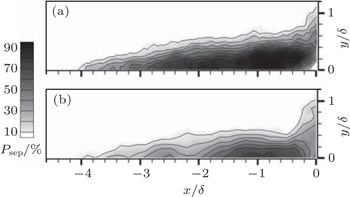 | Fig. 11. The separation probability Psep of the FFS flowfield (a) without a micro-ramp and (b) with micro-ramps. |
Since the size of the separated bubble is correlated with the position of the separation shock,[13,20] it is expected that when the size/unsteadiness of the separated bubble decreases, the unsteadiness of the separation shock also reduces. After the shock wave, there is a great velocity gradient. Therefore, the shock position can be determined by locating the biggest velocity gradient along the x direction at different wall-normal locations. In order to evaluate the unsteadiness of the separation shock, its location is calculated by finding the maximum of dV/dx along the horizontal line y = 3δ. The same procedure is repeated for the five rows of vectors above and below this line. After removing obvious edges, the separation shock locations are obtained in a least squares fitting procedure. This linear fit is employed to calculate the shock position at y = 3δ.[13] The process is repeated for all 500 images, then the separation shock unsteadiness is represented by the standard deviation σ of shock locations xs at y = 3δ. Without control of a micro-ramp, the standard deviation σ (xs) is 1.71, while with micro-ramps it decreases to 1.26. The reduction in separation shock unsteadiness is 26% with the control of the micro-ramps.
The flow control effects of the micro-ramps on Mach 3 turbulent flow over a forward-facing step was experimentally investigated in a supersonic low-noise wind tunnel using NPLS and PIV techniques. High spatiotemporal resolution flow visualization and velocity fields were captured. With the micro-ramps, the flow fields are dominated by intermittent large-scale structures generated by the micro-ramps, which can survive the downstream region of the FFS flowfield. After 10 μs, there are little changes in large-scale structures and the flow structures change slowly in form. Furthermore, the micro-ramps have almost no impact on the evolution characteristics of the flow structures. With the micro-ramps, the reduction in the range of the reversal flow zone in streamwise direction is 50%, the low speed region is greatly enlarged and the turbulence intensity is reduced. The reduction in the average separated region is 47%, which is rather close to the reduction in the streamwise scope of the reversal flow region. Moreover, the reduction in separation shock unsteadiness is 26% with the control of the micro-ramps. The results show that the micro-ramps are effective in controlling the supersonic FFS flow.
| 1 | |
| 2 | |
| 3 | |
| 4 | |
| 5 | |
| 6 | |
| 7 | |
| 8 | |
| 9 | |
| 10 | |
| 11 | |
| 12 | |
| 13 | |
| 14 | |
| 15 | |
| 16 | |
| 17 | |
| 18 | |
| 19 | |
| 20 |






